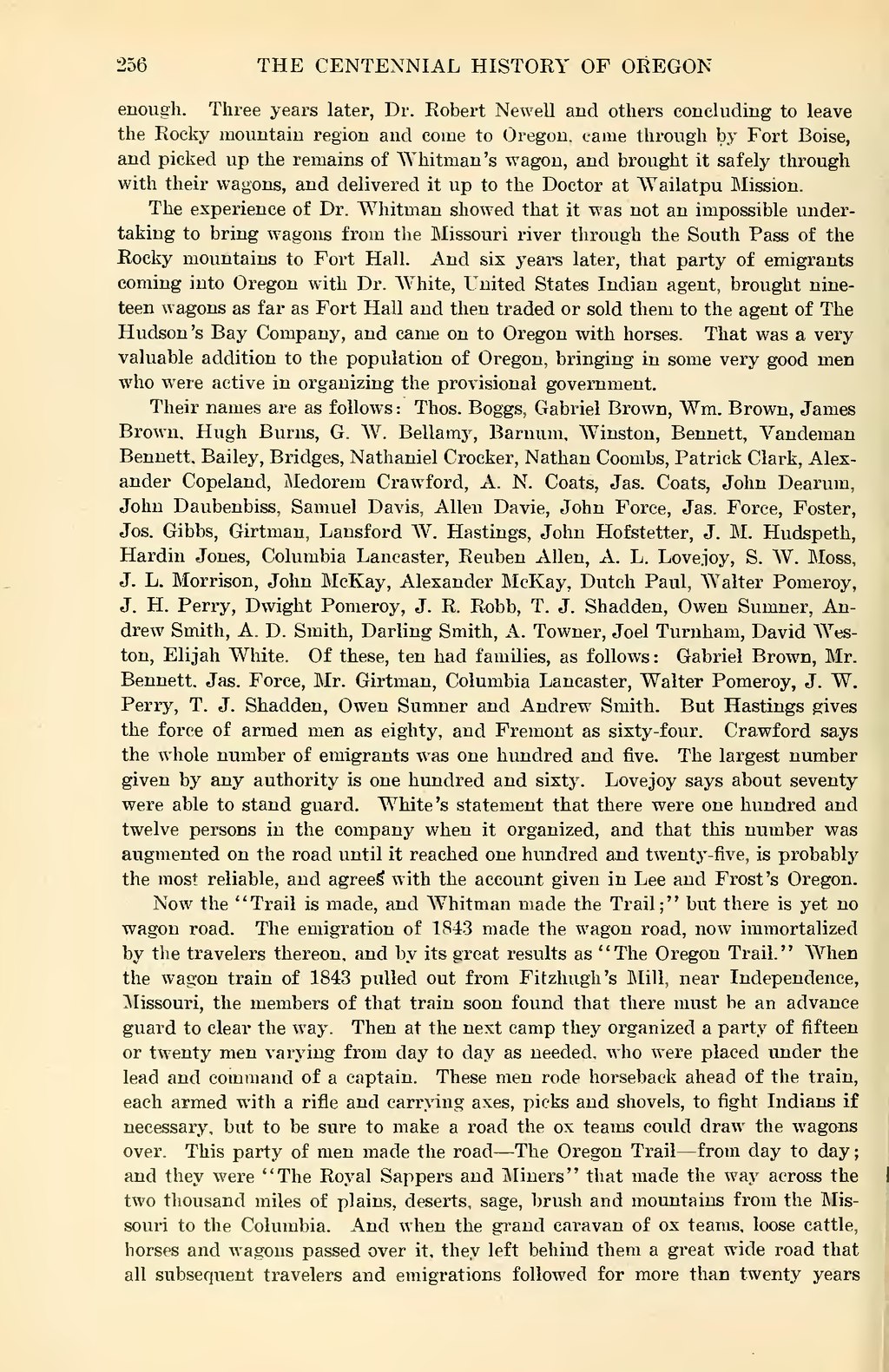enough. Three years later, Dr. Robert Newell and others concluding to leave the Rocky mountain region and come to Oregon, came through by Fort Boise, and picked up the remains of Whitman's wagon, and brought it safely through with their wagons, and delivered it up to the Doctor at "Wailatpu Mission.
The experience of Dr. Whitman showed that it was not an impossible under- taking to bring wagons from the Missouri river through the South Pass of the Eocky mountains to Fort Hall. And six years later, that party of emigrants coming into Oregon with Dr. White, United States Indian agent, brought nine- teen wagons as far as Fort Hall and then traded or sold them to the agent of The Hudson's Bay Company, and came on to Oregon with horses. That was a very valuable addition to the population of Oregon, bringing in some very good men who were active in organizing the provisional government.
Their names are as follows: Thos. Boggs, Gabriel Brown, Wm. Brown, James Brown, Hugh Burns, G. W. Bellamy, Barnum, Winston, Bennett, Vandeman Bennett, Bailey, Bridges, Nathaniel Crocker, Nathan Coombs, Patrick Clark, Alex- ander Copeland, Medorem Crawford, A. N. Coats, Jas. Coats, John Dearum, John Daubenbiss, Samuel Davis, Allen Davie, John Force, Jas. Force, Foster, Jos. Gibbs, Girtman, Lansford W. Hastings, John Hofstetter, J. M. Hudspeth, Hardin Jones, Columbia Lancaster, Reuben Allen, A. L. Lovejoy, S. W. Moss, J. L. Morrison, John McKay, Alexander McKay, Dutch Paul, Walter Pomeroy, J. H. Perry, Dwight Pomeroy, J. R. Robb, T. J. Shadden, Owen Sumner, An- drew Smith, A. D. Smith, Darling Smith, A. Towner, Joel Turnham, David Wes- ton, Elijah White. Of these, ten had families, as follows : Gabriel Brown, Mr. Bennett. Jas. Force, Mr. Girtman, Columbia Lancaster, Walter Pomeroy, J. W. Perry, T. J. Shadden, Owen Sumner and Andrew Smith. But Hastings gives the force of armed men as eighty, and Fremont as sixty-four. Crawford says the whole number of emigrants was one hundred and five. The largest number given by any authority is one hundred and sixty. Lovejoy says about seventy were able to stand guard. White's statement that there were one hundred and twelve persons in the company when it organized, and that this number was augmented on the road until it reached one hundred and twenty-five, is probably the most reliable, and agreed with the account given in Lee and Frost's Oregon.
Now the "Trail is made, and Whitman made the Trail;" but there is yet no wagon road. The emigration of 1843 made the wagon road, now immortalized by the travelers thereon, and by its great results as "The Oregon Trail." When the wagon train of 1843 pulled out from Fitzhugh's Mill, near Independence, Missouri, the members of that train soon found that there must be an advance guard to clear the way. Then at the next camp they organized a party of fifteen or twenty men varying from day to day as needed, who were placed under the lead and command of a captain. These men rode horseback ahead of the train, each armed with a rifle and carrying axes, picks and shovels, to fight Indians if necessary, but to be sure to make a road the ox teams could draw the wagons over. This party of men made the road — The Oregon Trail — from day to day; and they were "The Royal Sappers and Miners" that made the way across the two thousand miles of plains, deserts, sage, brush and mountains from the Missouri to the Columbia. And when the grand caravan of ox teams, loose cattle, horses and wagons passed over it, they left behind them a great wide road that all subsequent travelers and emigrations followed for more than twenty years
